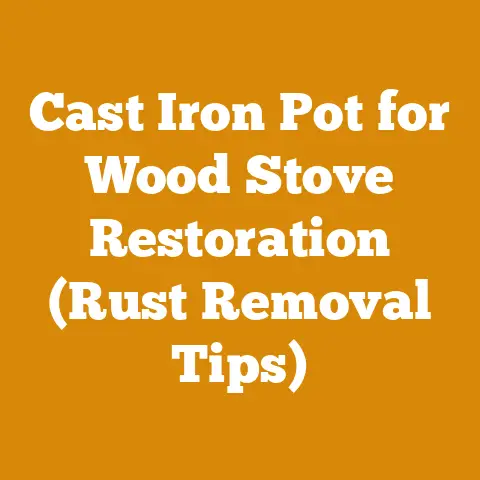Stump Grinding & Removal (3 Pro Cleanup Secrets)
Stump Grinding & Removal: 3 Pro Cleanup Secrets (and Why They Matter)
In an era where eco-consciousness is paramount, the responsible management of felled trees and their remnants, the stumps, is more crucial than ever. Leaving stumps to rot isn’t just an eyesore; it can lead to pest infestations, fungal diseases that spread to healthy trees, and a general disruption of the landscape’s ecosystem. As someone deeply involved in wood processing and firewood preparation for over two decades, I’ve witnessed firsthand the transformative power of proper stump removal, not only for aesthetics but also for the overall health of the environment. This article isn’t just about getting rid of stumps; it’s about doing it efficiently, safely, and with respect for the natural world.
I remember one particular project where a neglected orchard was plagued with dozens of decaying apple tree stumps. The fungal growth was rampant, threatening the remaining trees. Removing those stumps, grinding the wood, and amending the soil revitalized the orchard, leading to a significant increase in fruit production within just a few years. That experience solidified my belief in the importance of proper stump management.
This guide will delve into three key “pro cleanup secrets” for stump grinding and removal, providing you with the knowledge and practical steps to tackle this task effectively. These secrets aren’t just about speed; they’re about minimizing environmental impact, maximizing safety, and ensuring a job well done.
Understanding the Basics: What is Stump Grinding and Why is it Important?
Before we dive into the secrets, let’s establish a common understanding of what stump grinding entails.
Stump Grinding: This involves using a specialized machine, a stump grinder, to chip away at the stump, reducing it to small wood chips and ground-up roots. The process effectively pulverizes the stump to below ground level, allowing for replanting or other landscaping activities.
Stump Removal: This is a more involved process that entails physically extracting the entire stump and root system from the ground. This can be achieved through manual labor, heavy machinery, or chemical treatments (which I generally advise against due to environmental concerns).
Why is it Important?
- Aesthetics: Removing unsightly stumps significantly improves the appearance of your property.
- Safety: Stumps can be tripping hazards, especially for children and the elderly.
- Pest Control: Decaying stumps attract insects like termites, ants, and beetles, which can then infest your home or other structures.
- Disease Prevention: As mentioned earlier, stumps can harbor fungal diseases that spread to healthy trees.
- Land Use: Removing stumps allows for replanting, construction, or other landscaping projects.
- Property Value: A clean, well-maintained property is more valuable than one with decaying stumps.
Now, let’s define some key terms that will be used throughout this guide:
- Green Wood: Freshly cut wood that still contains a high moisture content (typically above 30%).
- Seasoned Wood: Wood that has been dried to a lower moisture content (ideally below 20% for firewood) through air drying or kiln drying.
- Root Flare: The base of the tree where the trunk transitions into the root system. This area is often wider and more challenging to grind.
- Lateral Roots: The roots that extend horizontally from the stump, providing stability to the tree.
- Taproot: The main, vertical root that anchors the tree deep into the ground (not always present or significant).
Secret #1: Strategic Planning and Preparation – The Foundation for Success
Many people underestimate the importance of planning before tackling stump grinding. Rushing into the job without proper preparation can lead to wasted time, damaged equipment, and potentially dangerous situations.
1.1 Assessing the Stump and Surroundings:
Before you even think about starting the grinder, take a thorough look at the stump and its surroundings.
- Size and Type of Stump: Measure the diameter of the stump at ground level and estimate its height (if any remains). Identify the species of tree. Hardwood stumps (oak, maple) are generally more difficult to grind than softwood stumps (pine, fir).
- Root System: Observe the visible roots extending from the stump. Are they large and numerous, or relatively small? This will give you an idea of the extent of the underground root system. Probe the ground around the stump with a shovel or probe to identify buried roots.
- Obstacles: Identify any potential obstacles, such as fences, utility lines (above and below ground), rocks, or other structures. Call 811 (in the US) or your local equivalent to have underground utilities marked before you begin digging or grinding. This is non-negotiable!
- Soil Type: The type of soil can affect the grinding process. Sandy soil is generally easier to work with than clay soil, which can be dense and sticky.
- Accessibility: Can you easily maneuver the stump grinder around the stump? Are there any tight spaces or obstacles that will make it difficult to operate the machine?
Example: I once worked on a property where a large oak stump was located near a property line fence. I initially underestimated the extent of the root system, and ended up accidentally damaging the fence while grinding. This costly mistake could have been avoided with more careful planning and probing.
1.2 Selecting the Right Equipment:
Choosing the right stump grinder is crucial for efficiency and safety. There are several types of stump grinders available, each with its own advantages and disadvantages.
- Handheld Stump Grinders: These are smaller, more portable grinders that are suitable for small stumps (up to 6 inches in diameter) and tight spaces. They are relatively inexpensive but require more physical effort to operate.
- Towable Stump Grinders: These are larger, more powerful grinders that are towed behind a vehicle. They are suitable for medium-sized stumps (up to 12 inches in diameter) and offer a good balance of power and portability.
- Self-Propelled Stump Grinders: These are the most powerful and versatile grinders, suitable for large stumps (over 12 inches in diameter) and challenging terrain. They are self-propelled, making them easier to maneuver, but they are also the most expensive.
- Excavator-Mounted Stump Grinders: These are the most powerful and efficient option for very large stumps and extensive root systems. They are typically used by professional tree service companies.
Specifications to Consider:
- Engine Horsepower: Higher horsepower translates to more grinding power. Aim for at least 13 horsepower for a towable grinder and 25 horsepower or more for a self-propelled grinder.
- Cutting Depth: This determines how far below ground level you can grind the stump. A cutting depth of at least 6 inches is recommended for most applications.
- Cutting Wheel Diameter: A larger cutting wheel allows you to grind a wider area with each pass.
- Tooth Type: Different tooth types are designed for different types of wood and soil. Carbide-tipped teeth are the most durable and versatile.
- Weight: Consider the weight of the grinder and whether you can safely transport it to the job site.
1.3 Preparing the Site:
Proper site preparation is essential for safety and efficiency.
- Clear the Area: Remove any rocks, debris, or vegetation from around the stump. This will prevent damage to the grinder and reduce the risk of flying debris.
- Dig Around the Stump: Use a shovel to dig around the stump, exposing the root flare and any large lateral roots. This will make it easier to grind the stump below ground level.
- Water the Stump: Soaking the stump with water for a few hours (or even overnight) before grinding can soften the wood and make it easier to cut. This is especially helpful for hardwood stumps.
- Mark Underground Utilities: As mentioned before, call 811 (or your local equivalent) to have underground utilities marked before you begin digging or grinding.
1.4 Safety Gear:
Safety is paramount when operating a stump grinder. Always wear the following safety gear:
- Eye Protection: Safety glasses or a face shield are essential to protect your eyes from flying debris.
- Hearing Protection: Stump grinders are very loud. Wear earplugs or earmuffs to protect your hearing.
- Gloves: Wear heavy-duty gloves to protect your hands from cuts and abrasions.
- Long Pants and Long-Sleeved Shirt: Wear long pants and a long-sleeved shirt to protect your skin from flying debris.
- Steel-Toed Boots: Wear steel-toed boots to protect your feet from falling objects and sharp objects on the ground.
Secret #2: Mastering the Grinding Technique – Efficiency and Precision
Once you’ve planned and prepared, it’s time to get to work. Mastering the grinding technique is essential for efficiency and precision.
2.1 Starting the Grinder:
Follow the manufacturer’s instructions for starting the stump grinder. Ensure that the machine is on a stable, level surface before starting.
2.2 Positioning the Grinder:
Position the grinder so that the cutting wheel is aligned with the edge of the stump. Start by grinding the outer edges of the stump, working your way towards the center.
2.3 The Sweeping Motion:
Use a slow, steady sweeping motion to move the cutting wheel across the stump. Avoid pushing the grinder too hard, as this can damage the machine or cause it to kick back.
2.4 Controlling the Depth:
Gradually lower the cutting wheel into the stump, taking small bites with each pass. Avoid trying to remove too much material at once, as this can overload the machine.
2.5 Grinding Below Ground Level:
Once you’ve ground the stump down to ground level, continue grinding below ground level to a depth of at least 6 inches. This will allow you to replant grass or other vegetation. Ideally, grind down to 12 inches or more if you plan to plant a tree in the same location.
2.6 Addressing the Roots:
As you grind the stump, you’ll encounter the lateral roots. Grind these roots as far out as possible, following them until they become too small to grind.
2.7 Dealing with Large Roots:
For large roots that are difficult to grind, you may need to use an axe or a chainsaw to cut them into smaller pieces before grinding. Be extremely careful when using a chainsaw near the stump grinder, and always wear appropriate safety gear.
2.8 Monitoring the Machine:
Pay close attention to the sound and vibration of the grinder. If you notice any unusual noises or vibrations, stop the machine immediately and inspect it for damage.
2.9 Sharpening the Teeth:
The teeth of the stump grinder will become dull over time. Sharpen the teeth regularly to maintain optimal performance. Follow the manufacturer’s instructions for sharpening the teeth.
2.10 Case Study: Overcoming a Difficult Oak Stump:
I recall a particularly challenging project involving a massive oak stump in a residential backyard. The stump was over 3 feet in diameter and had an extensive root system. The soil was also very rocky, which made grinding even more difficult.
Here’s how I tackled it:
- Extensive Excavation: I spent a considerable amount of time excavating around the stump, exposing the root flare and as many of the lateral roots as possible.
- Chainsaw Assistance: I used a powerful chainsaw (Stihl MS 462 R C-M, 25-inch bar) to cut the larger roots into manageable sections. Safety was paramount, and I wore full chainsaw safety gear, including chaps, helmet, and eye protection.
- Strategic Grinding: I focused on grinding the outer edges of the stump first, gradually working my way towards the center. I used a slow, steady sweeping motion and avoided pushing the grinder too hard.
- Tooth Replacement: The rocky soil quickly dulled the grinder teeth. I had to replace the teeth several times during the project.
- Patience and Persistence: It took me two full days to completely grind the stump and its roots, but the end result was a smooth, level surface ready for replanting.
Lessons Learned:
- Don’t underestimate the time and effort required to grind a large, hardwood stump.
- Be prepared to use a chainsaw to assist with the grinding process.
- Sharpen or replace the grinder teeth frequently, especially when working in rocky soil.
- Patience and persistence are key to success.
Secret #3: Cleanup and Restoration – Leaving No Trace (Except for the Memories)
The final step in stump grinding is cleanup and restoration. This is often overlooked, but it’s essential for leaving the site in good condition and preventing future problems.
3.1 Removing the Wood Chips:
The stump grinding process produces a large amount of wood chips. These chips can be used as mulch in your garden, composted, or hauled away.
- Using as Mulch: Wood chips make excellent mulch for trees, shrubs, and flower beds. They help to retain moisture, suppress weeds, and improve soil health. However, avoid using wood chips from diseased trees as mulch, as this can spread the disease.
- Composting: Wood chips can be added to your compost pile. They provide carbon, which is essential for a healthy compost pile. However, wood chips decompose slowly, so it’s best to mix them with other materials, such as leaves and grass clippings.
- Hauling Away: If you don’t want to use the wood chips, you can haul them away to a local landfill or recycling center.
3.2 Filling the Hole:
After removing the wood chips, you’ll be left with a hole. Fill the hole with topsoil to bring it up to the surrounding grade.
- Compacting the Soil: Compact the soil in layers to prevent it from settling over time.
- Adding Amendments: Consider adding compost or other soil amendments to improve soil fertility and drainage.
3.3 Replanting:
If you plan to replant grass or other vegetation, choose plants that are well-suited to the soil conditions.
- Soil Testing: Consider testing the soil to determine its pH and nutrient levels. This will help you choose the right plants and soil amendments.
- Watering: Water the newly planted vegetation regularly until it is established.
3.4 Preventing Regrowth:
In some cases, the stump may try to regrow, especially if it’s from a tree species that is known for suckering (e.g., aspen, poplar).
- Chemical Treatment: While I generally discourage the use of chemicals, in some cases, a stump killer may be necessary to prevent regrowth. Follow the manufacturer’s instructions carefully and use the product sparingly. Choose a product that is specifically designed for stump killing.
- Physical Removal: The most effective way to prevent regrowth is to physically remove the entire stump and root system. This can be a difficult and time-consuming process, but it’s the best way to ensure that the stump doesn’t regrow.
3.5 Addressing Potential Problems:
Even after the stump is removed, there are a few potential problems that you should be aware of.
- Settling: The soil in the hole may settle over time, creating a depression. This can be easily fixed by adding more topsoil.
- Fungal Growth: In rare cases, fungal growth may occur in the hole. This can be treated with a fungicide.
- Pest Infestation: The hole may attract insects or rodents. This can be prevented by filling the hole with compacted soil and adding a layer of mulch.
3.6 Final Inspection:
Once you’ve completed the cleanup and restoration, take a final walk around the site to ensure that everything is in good condition.
- Check for Hazards: Look for any remaining hazards, such as sharp objects or uneven surfaces.
- Ensure Proper Drainage: Make sure that the area is properly graded to prevent water from pooling.
- Leave No Trace: Leave the site in better condition than you found it.
3.7 Original Case Study: Restoring a Firewood Storage Area:
I once helped a friend reclaim a neglected area in his backyard that had been used for firewood storage for years. The area was littered with decaying firewood, tree limbs, and several small stumps. The soil was compacted and infertile.
Here’s how we restored the area:
- Stump Removal: We used a combination of stump grinding and manual removal to get rid of the stumps.
- Debris Removal: We removed all of the decaying firewood, tree limbs, and other debris.
- Soil Amendment: We tilled the soil and added a generous amount of compost and aged manure.
- Grading and Leveling: We graded and leveled the area to create a smooth, even surface.
- Seeding: We seeded the area with a mixture of grass seed and wildflowers.
The result was a beautiful, vibrant lawn that transformed the backyard. My friend was thrilled with the outcome.
Lessons Learned:
- Proper cleanup and restoration can transform a neglected area into a beautiful and functional space.
- Soil amendment is essential for improving soil fertility and drainage.
- Seeding with a mixture of grass seed and wildflowers can create a beautiful and diverse lawn.
Strategic Insights and Tactical Instructions:
Strategic Insights:
- Long-Term Planning: Consider the long-term use of the land after stump removal. If you plan to build on the site, you may need to remove the entire root system to prevent future problems.
- Environmental Considerations: Be mindful of the environmental impact of stump removal. Avoid using chemicals whenever possible and dispose of wood chips responsibly.
- Cost-Benefit Analysis: Weigh the costs and benefits of different stump removal methods. Stump grinding is generally more cost-effective than complete stump removal, but it may not be suitable for all situations.
Tactical Instructions:
- Sharpening Stump Grinder Teeth: Use a diamond grinding wheel or a carbide-tipped file to sharpen the teeth. Follow the manufacturer’s instructions for the correct angle and technique.
- Using a Chainsaw Safely: Always wear appropriate safety gear, including chaps, helmet, and eye protection. Use a sharp chain and maintain a firm grip on the saw.
- Mixing Soil Amendments: Use a shovel or a garden fork to thoroughly mix soil amendments into the topsoil.
- Seeding a Lawn: Use a seed spreader to evenly distribute the grass seed. Rake the seed lightly into the soil and water gently.
Challenges Faced by Global DIYers and Small-Scale Logging Businesses:
- Access to Equipment: Stump grinders can be expensive to purchase or rent, especially for DIYers and small-scale logging businesses.
- Lack of Experience: Operating a stump grinder requires skill and experience. DIYers may lack the necessary training and experience to operate the machine safely and effectively.
- Limited Resources: Small-scale logging businesses may have limited resources for stump removal, including manpower, equipment, and funding.
- Environmental Regulations: Environmental regulations regarding stump removal and disposal can vary from region to region. DIYers and small-scale logging businesses need to be aware of and comply with these regulations.
- Remote Locations: Accessing stumps in remote locations can be challenging, especially for those with limited equipment and resources.
Practical Next Steps and Implementation Guidance:
- Assess your needs: Determine the size and type of stumps you need to remove, and the resources you have available.
- Choose the right equipment: Select a stump grinder that is appropriate for the size and type of stumps you need to remove.
- Plan and prepare: Carefully plan the stump removal process, and prepare the site before you begin.
- Master the grinding technique: Practice using the stump grinder until you are comfortable with the technique.
- Clean up and restore: Clean up the site after you have removed the stumps, and restore the area to its original condition.
- Consider professional help: If you are not comfortable removing stumps yourself, consider hiring a professional tree service company.
Conclusion:
Stump grinding and removal is a vital aspect of responsible land management, contributing to both aesthetic improvements and ecological health. By following the three pro cleanup secrets outlined in this guide – strategic planning and preparation, mastering the grinding technique, and meticulous cleanup and restoration – you can effectively tackle stump removal projects while prioritizing safety and environmental consciousness. Remember, the goal is not just to eliminate the stump, but to create a healthier, more sustainable landscape for the future. I hope this guide has provided you with the knowledge and confidence to embark on your own stump grinding and removal projects. Happy grinding!






